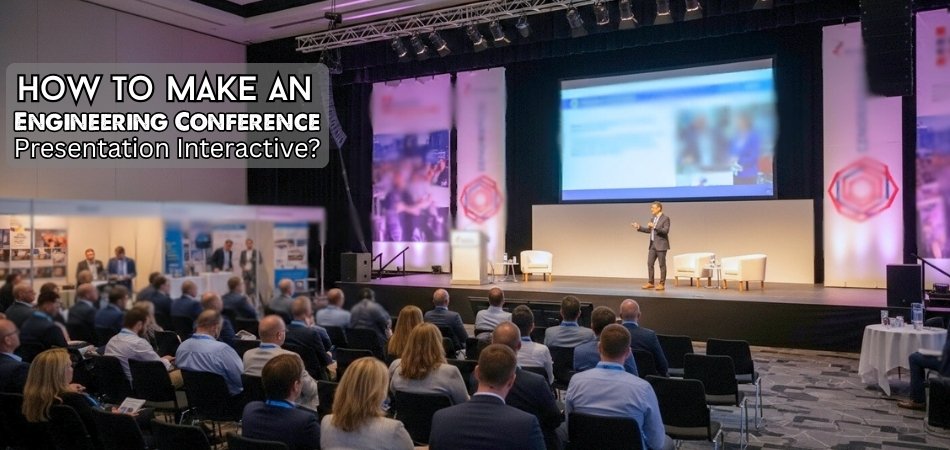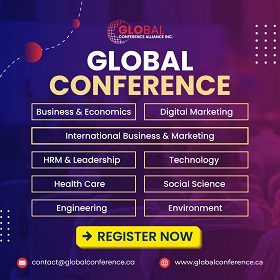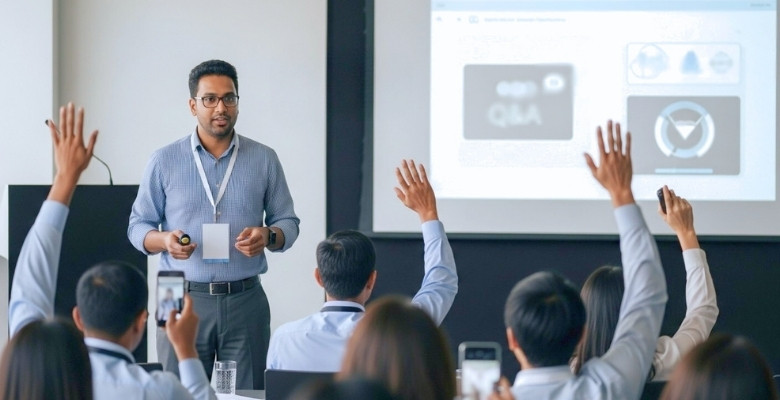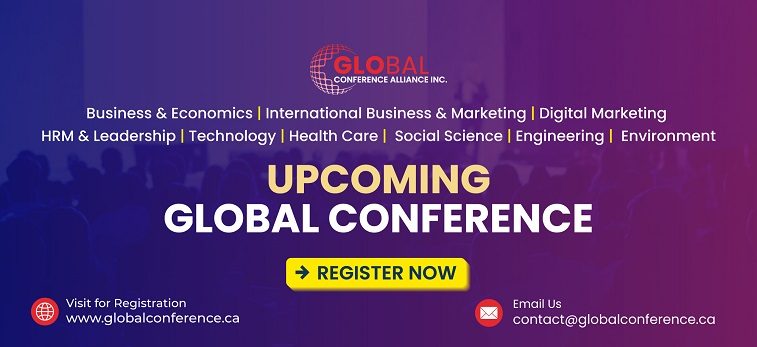Engineering conference presentations can be packed with smart ideas, but they don’t always hold people’s attention. Long talks filled with only facts can feel heavy and hard to follow. That’s why many presenters now look for ways to bring more energy and audience connection into their sessions—and that’s when the question comes up: how to make an engineering conference presentation interactive?
Make an engineering presentation interactive by using live polls, short quizzes, real visuals, small challenges, and audience questions. Move around, plan breaks, and end with engaging prompts to keep energy high and help attendees stay alert and involved.
Are you wondering how to use these interactive ideas without losing your topic’s depth or timing? Then you’re in the right place, because everything you need to know about planning and adding interaction into your talk is right here in this article.
How to Make an Engineering Conference Presentation Interactive?
Getting attention during an engineering conference isn’t always easy. People zone out if things get too serious or technical. But with the right mix of fun and interaction, your talk can really stand out. Let’s check out some simple ways to make it more engaging.

Know Your Crowd
It’s always smart to think about who you’ll be speaking to. Are they beginners, professionals, or a mix? Once you know that, shape your examples and stories around what they care about. A quick poll like “Who’s ever fixed a machine with tape and hope?” can get laughs and break the ice. If you’re planning for international events like conferences in USA, Canada, or any other country, understanding your audience becomes even more important.
Add Quick Polls
People love giving their opinion, even if it’s just clicking a button. Use simple tools like Slido or Wooclap to ask live questions during your talk. Show results on the screen instantly—it’s fun to see how opinions vary. For example, ask, “Which material would you pick for a stronger bridge?” It sparks conversation and helps you explain your point better as well.
Use Smart Quizzes
A short quiz now and then makes a big difference. After explaining a key idea, drop in a multiple-choice question or a fun true/false quiz. Keep it short and easy, not a test. This keeps the energy up and helps people remember the info better. It also tells you how well your audience is following along without putting pressure on them.
Walk Around
Instead of staying stuck behind the podium, try stepping down and walking a bit while you talk. It makes you feel more approachable and keeps the room alert. People naturally pay more attention when you move around. If you want, ask a quick question and let the crowd answer in pairs—it adds some movement and gives people a chance to speak, not just listen.
Use Small Challenges
Give your audience a tiny challenge to solve. It could be a mini design problem, a logic puzzle, or a real-life engineering “what would you do?” situation. Offer a small reward like a chocolate or a badge. These little games don’t just make the talk fun—they also bring out great ideas from the audience and keep the energy high.
Show Cool Stuff
Don’t just read off slides packed with text. Show a diagram, a real photo, or a short video that connects with your topic. Visuals make even boring topics feel interesting. If you’re explaining how something works, a before-and-after image or a simple animation can do wonders. People remember what they see more than what they hear.
Plan Break Moments
Every few minutes, pause for a quick moment of interaction. Ask a short question, take a poll, or just crack a light joke. These little breaks help reset people’s attention. When your audience expects something new every now and then, they stay more focused. It also makes your talk feel more like a conversation than a lecture.
Try Fun Formats
You don’t always have to stick to regular slides. You can use fast-paced formats like Ignite, where you show 20 slides for 15 seconds each. It keeps things moving quickly and forces you to stay clear and sharp. These formats are great when you want your talk to feel exciting and fresh, especially in events with multiple speakers.
End With a Spark
Wrap things up with something that sticks. Don’t just say thanks and walk off. Instead, ask the audience a fun question like, “What surprised you most today?” or “What will you try after this session?” You can even do a final quiz or poll. Ending on a high note helps people remember your message long after they leave the room.
Making your engineering presentation interactive doesn’t have to be complicated. Small changes can make a big difference in how people listen and respond. Try adding just a few of these ideas to keep your audience active and curious. The more fun they have, the more they’ll remember your talk.
Why Interactivity Matters in Engineering Conference Presentations?
Talking in front of a crowd is one thing, but getting people to actually care about what you’re saying is something else. That’s why interactive presentations are becoming a big deal at engineering events. Keep reading to find out why it really matters.
Builds Better Understanding
Your audience will understand your ideas better if you include questions, simple tasks, or group talks in your presentation. They don’t just sit there—they think, ask, and react. Even a quick example or a short poll can help explain a complex idea. People usually remember more when they’re part of the discussion instead of just listening to it. Interaction turns confusing stuff into something easier to follow and remember.
Keeps Everyone Focused
Let’s face it—most people stop paying attention after a few minutes. But when you keep things active, like asking quick questions or showing something cool, it brings their focus back. The talk feels shorter and more fun. It also makes your audience curious about what’s coming next. You don’t need fancy tricks—just simple moments that invite people to join in and stay alert.
Helps You Improve
Audience feedback is one of the best things about an interactive session. When people ask questions or give quick opinions, it shows you what they care about or what they didn’t get. You can use that info to explain things better or change how you present in the future. It’s like getting tips right from the people listening to you. You grow every time by learning what works and what doesn’t.
Sparks New Connections
After an interactive session, people often come up to talk, share their thoughts, or even ask for advice. These chats can lead to future teamwork or new ideas. Talking during the session also helps people in the audience connect with each other. Conferences in regions like the USA often emphasize engagement and real-world application. That’s why it’s worth considering interactivity early on—even while finding engineering conferences in the USA—so you can tailor your approach to the audience’s expectations.
Makes It Memorable
A talk full of facts is easy to forget, but a fun, active session stays in people’s minds. If someone laughed, solved a mini-challenge, or got to share an idea, they’ll likely remember that talk for a long time. It also makes your presentation stand out from all the others. Whether it’s a simple quiz or a live demo, that moment of connection sticks with people.
Interactive presentations do more than just break the silence—they help people learn better and stay involved. When the audience feels included, they listen more and remember more. It also opens doors for feedback and new connections. So next time, try making your talk a bit more active and see the difference it makes.
Effective Tools and Technologies to Use in Interactive Presentations for Engineering Conference
When you’re speaking at an engineering conference, just talking isn’t always enough to keep people interested. The right tools can turn a plain talk into something fun and easy to follow. With some simple tech, your audience can take part instead of just watching. Keep reading to find out which tools can help you make your next presentation more exciting and active.
- Slido and Mentimeter: These tools let you run live polls or quizzes. People vote using their phones, and results appear instantly on the screen.
- Audience Q&A Platforms: Platforms like Pigeonhole Live allow the audience to ask and upvote questions during your talk without interrupting.
- Mobile Apps: Some conferences have their own apps where attendees can interact, answer polls, or take part in quick games during presentations.
- Real-Time Simulations: Showing how something works in real-time—like a moving model or system response—makes your explanation clear and exciting.
- Augmented Reality (AR): You can use AR to show 3D models of machines or buildings right on the screen or through an app.
- Virtual Reality (VR): VR headsets can give a short, hands-on experience of complex projects that would be hard to explain with just slides.
- Interactive Slides: Use tools like Prezi or Canva that allow you to zoom in, click, and move through your slides in a more interesting way.
The more your audience can interact, the more they’ll enjoy your session. These tools don’t require high skills—just a bit of planning and creativity. You don’t need to use them all; even one or two can make a big difference. So, give them a try and watch your next talk come alive.
Types of Interactive Elements You Can Add to an Engineering Conference Presentation
Making a conference presentation fun and interesting isn’t as hard as it seems. You don’t need to be a tech expert or use big tools. Just adding a few simple interactive ideas can really change the mood. Let’s explore how you can make your talk more active and exciting.
Live Polls
You can ask your audience a quick question and let them vote live. Use tools like Slido or Mentimeter so they can use their phones easily. When the results pop up, people get curious and start paying attention. It’s a simple way to break the silence in the room. You also get to know what your audience is thinking right away without guessing anything.
Q&A Breaks
Taking short breaks to answer questions helps keep people more involved. It also makes your session feel like a two-way talk, not just a lecture. These little breaks give the audience time to think and speak. Some people ask better questions when they don’t have to wait long. This keeps the talk active and gives space for real-time learning too.
Quick Demos
Showing a small working demo helps explain things better than just words. You can use a model, a tool, or even a short video. It grabs everyone’s attention and gives them something real to remember. Demos also keep the session fresh, especially after lots of talking. They don’t need to be long—just clear, simple, and related to your main topic.
Audience Prompts
Asking the crowd a question makes them feel part of your talk. You can let them discuss with the person sitting next to them. This creates energy in the room without needing any fancy tools. Even one or two prompts can make the session feel more friendly. It works well for both small and large groups of people.
Visual Interactions
Moving slides and clickable parts make your visuals come alive on screen. Try using tools like Prezi or Canva for zoom and click effects. This keeps the audience looking at the screen and not getting bored. You can show steps, highlight ideas, or explain a point more clearly. People remember pictures better, especially when they get to interact with them.
Interactive elements make your talk more fun and easy to follow. You don’t need to use all of them—just try one or two. It helps people stay alert and enjoy your session more. Small efforts like these can leave a big impact.
How to Use Humor and Human Connection to Spark Interaction in Engineering Conference Presentations?
Making a room full of people smile or laugh during a technical talk may sound tricky. But adding a little humor or real-life stories can make things easier for everyone. It helps people connect with you and enjoy the topic more. Keep reading to learn how simple touches can bring your talk to life.
Light Jokes
Cracking a small joke at the right time can make people smile and relax. You don’t need to be a comedian—just share a fun thought about your topic. It could be a silly mistake you made once or a funny fact about your work. Keep it clean, short, and friendly. This helps break the ice and makes people more open to listening and talking.
Funny Slides
Sometimes, your slide can do the joking for you. Use a funny picture, meme, or cartoon that relates to your topic. A good visual joke makes people laugh and pay closer attention. Make sure it connects with your point so it still adds meaning. A little humor in your slides also gives the audience a short mental break.
Personal Stories
Sharing a short story from your own experience helps people feel close to you. It could be a small fail, a surprising moment, or a time something didn’t go as planned. These honest stories are often funny without trying too hard. Plus, they show the human side of technical work and invite others to share too.
Friendly Language
The way you talk can also make a big difference. Use simple words and a relaxed tone like you’re talking to a friend. Smile, keep eye contact, and don’t be afraid to laugh a little. When you sound natural, the audience feels more comfortable too. This kind of connection helps people stay interested and respond better.
Relatable Moments
Think about things your audience also goes through—common mistakes, weird habits, or confusing tools. Mentioning these shared experiences makes your audience nod, laugh, or even speak up. It shows that you understand them and that you’ve been in their shoes. These moments are great for starting small talks or asking questions during your session.
Adding humor and real stories makes technical talks feel more alive and real. People enjoy listening when they feel connected to the speaker. It also helps them stay focused and ask more questions. A simple smile or a funny moment can make your session unforgettable.
Tips for Balancing Interactivity With Technical Depth for Engineering Conference Presentation
Presenting something technical doesn’t mean it has to be boring or too serious. The trick is keeping people interested while still sharing smart and detailed ideas. It might take a bit of planning, but it’s totally doable. Here are some easy tips to help you find the right balance.
- Know Your Main Point: Focus on the one big idea people should remember instead of trying to explain everything at once.
- Use Simple Examples: Relate hard topics to things people already understand, like daily tools, games, or common problems.
- Break It Into Parts: Divide tough topics into small chunks, so the audience can follow without getting lost in long explanations.
- Ask Smart Questions: Instead of just talking, ask the audience quick questions to get them thinking about the topic you’re explaining.
- Show Before Details: Start with what the thing does or solves, and then slowly explain how it works step by step.
- Use Clean Visuals: Add simple drawings, charts, or diagrams to make technical points easier to see and understand without needing big words.
- Add Small Activities: Give the audience short tasks like guessing a result or solving a quick challenge to keep them involved and thinking.
Balancing fun and deep content isn’t about choosing one or the other. You just need to guide your audience step by step in a clear way. Keep things moving but still meaningful. A mix of both can make your session stand out.
Mistakes to Avoid When Presenting at an Engineering Conference
Standing in front of a crowd to give a talk can feel exciting and scary. Even with good content, a few simple mistakes can make people lose interest. Knowing what to avoid can help make things go smoother. Keep reading to learn what to watch out for during your next presentation.
Too Many Gimmicks
Trying too hard to be funny or different can sometimes backfire. A few jokes or games are fine, but using them too much can distract people. If your audience can’t follow the main topic, the extra stuff doesn’t help. Make sure your fun parts support your message, not cover it up. Keep the focus on clear ideas and real value.
Skipping Audience Reactions
If someone seems confused or doesn’t pay attention, pause. Ignoring those moments and rushing ahead can make your whole talk feel flat. Watching faces, body language, or small reactions helps you adjust quickly. Slow down, explain again, or ask a question to get them back. Your talk should feel like a two-way conversation, not a one-way list.
Assuming Too Much
It’s easy to think everyone knows the basics, but that’s not always true. If you skip simple steps or use big words without explaining, people get lost fast. Always check the room’s knowledge level with a quick question or poll. Then match your talk to what they really know. It’s better to explain a bit more than leave people confused.
Breaking the Flow
Stopping too often or changing topics quickly can break the rhythm of your talk. Every time you jump around, people have to refocus, and some get lost. Try to keep your points in order and move smoothly between them. Use simple slides or short examples to help connect ideas. A strong flow keeps your audience following and enjoying your talk.
Talking Too Much
Filling every second with words doesn’t mean your talk is strong. Sometimes, long explanations or too many facts can wear people out. Give short pauses or quick questions to let the audience think. A few clear points are better than trying to say everything at once. Less talking, more meaning—that’s what keeps people interested.
Even great speakers can lose the room by making small mistakes. The key is to stay clear, listen to your audience, and keep things steady. Don’t try to impress—just connect and explain. A little awareness makes a big difference.
Tips to Prepare Interactive Presentation Elements Without Losing Flow in Engineering Conferences
Adding interaction to a technical talk can make it more fun and easier to follow. But if it’s not planned right, it can break the flow and confuse the audience. That’s why timing matters just as much as the tools you use. Let’s explore how to place these moments in a way that feels smooth and natural.
Use It as a Starter
Beginning your session with a short poll or light question helps everyone feel involved right away. It sets a friendly tone and grabs attention early. You can ask something simple related to your topic or just for fun. This warm-up keeps people alert and ready for the content that follows. It’s a smooth way to start without jumping straight into complex details.
Insert at Key Points
A good time to add an interactive moment is right after a big idea. When you finish explaining something important, pause and ask a question or start a quick quiz. This helps people remember the point better and keeps them thinking. It also gives you a break to check if the audience is following. Use this as a way to slow down without losing interest.
Make It a Bridge
Sometimes you need to move from one topic to the next. That’s a great spot to add a short activity, poll, or question. It helps wrap up one idea while getting everyone ready for the next one. This keeps the talk flowing and gives people time to reset. These small breaks help keep energy high without feeling like a big stop.
Tie It to Examples
You can bring a dry topic to life by adding a quick challenge or demo right after a technical part. For example, after explaining a process, ask the audience to guess what would happen in a certain situation. This works well in both live and online talks. Planning for different delivery environments—especially online formats—can help maintain flow and boost the effectiveness of online engineering conferences through carefully timed interactive elements.
Keep It Short
Even if the idea is fun, long activities can drag down the talk. Make sure each interactive part is short and easy to follow. One or two minutes is usually enough to keep the energy up. Always keep an eye on the time so your session doesn’t feel rushed at the end. Simple and fast ideas work best between technical points.
Interactive pieces are most helpful when they fit naturally into the flow. You don’t need too many—just the right ones in the right spots. They help people stay interested without losing the main message. With a little planning, your talk can be both smart and fun.
FAQs About How to Make an Engineering Conference Presentation Interactive?
Here’s a short FAQ section to clear up common doubts and help make your presentation even better. These extra tips can guide you through smaller but important parts of making your engineering conference talk interactive. If you’re planning one soon, these answers will really come in handy.
How Do I Start My Presentation Without Losing Interest?
Start your presentation with a light question or an interesting fact related to your topic. This helps break the silence and sets a friendly tone. Avoid jumping straight into heavy information right away. A smooth, simple start keeps people relaxed and ready to listen.
What If My Audience Doesn’t Respond?
If your audience stays quiet, try changing your approach by asking simpler or fun questions. Give them a moment to think or chat with someone next to them. Not everyone speaks up quickly, so don’t rush. Stay calm and keep trying with friendly energy.
Can I Use Props in My Presentation?
Yes, simple props can help explain your point better and make your talk stand out. Use items that relate to your topic and are easy to show. For example, a small tool or model can make a technical idea easier to understand. Just keep it short and clear.
How Do I Manage My Time With Interactive Parts?
Plan your talk like a timeline and add short interaction points between sections. Keep each activity or question under two minutes. Always check your watch or timer to stay on track. Practicing with a timer beforehand really helps.
What If I Get a Question I Can’t Answer?
If someone asks something you don’t know, it’s okay to say, “I’ll look into it.” You can also ask if anyone else in the room has a thought. This builds a friendly space for sharing ideas. Just be honest and confident.
How Can I Keep My Voice Interesting?
Change your tone depending on what you’re saying—use more energy for fun parts and slow down for serious ones. Don’t talk in one flat voice the whole time. Add pauses where it feels right. This helps your audience stay focused.
Is It Okay to Add a Personal Touch?
Yes, sharing something small about your own experience makes you more relatable. It could be a funny moment or a simple lesson you learned. Just keep it short and connect it to your main topic. People like hearing from real people, not just slides.
How Do I Handle a Technical Glitch?
If your tool or slide doesn’t work, don’t panic—stay calm and talk through the point. You can explain the idea with your words or draw it out. Keep a backup plan, like printed slides or simple visuals. Most people understand that these things happen.
Can I Involve the Audience Without Tech Tools?
Yes, you can ask them to raise their hands, share thoughts in pairs, or give a quick shout-out. These are simple but still make people feel included. Not every interaction needs a screen or app. Keep it light and easy.
How Can I End My Talk With a Strong Finish?
Wrap up by repeating the key point you want them to remember. Then ask a short question like, “What part will you try next?” This helps your message stick. Ending with a smile or final poll keeps the mood positive and fresh.
Conclusion
Making your talk more engaging doesn’t need fancy tools or big changes. With small steps like quick polls, real-life stories, and fun activities, you now know exactly how to make an engineering conference presentation interactive in a simple, smart, and memorable way.
Before your next session, take time to plan your flow, know your audience, and time your activities well. Keep your tone friendly, enjoy the moment, and most importantly, have fun with it. Good luck, and may your next presentation be your best one yet!








